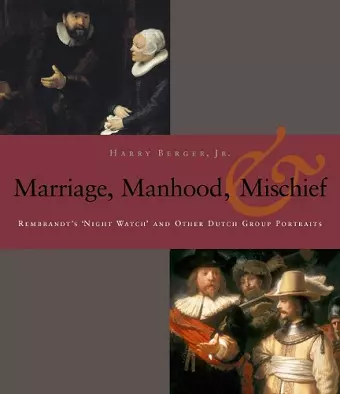Manhood, Marriage, and Mischief
Rembrandt's 'Night Watch' and Other Dutch Group Portraits
Format:Paperback
Publisher:Fordham University Press
Published:16th Apr '06
Currently unavailable, and unfortunately no date known when it will be back

A study of the theory and practice of seventeenth-century Dutch group portraits, Manhood, Marriage, and Mischief offers an account of the genre's comic and ironic features, which it treats as comments on the social context of portrait sitters who are husbands and householders as well as members of civic and proto-military organizations.
The introduction picks out anomalous touches with which Rembrandt problematizes standard group-portrait motifs in The Night Watch: a shooter who fires his musket into the company; two girls who appear to be moving through the company in the wrong direction; guardsmen who appear to be paying little or no attention to their leader's enthusiastic gesture of command.
Were the patrons and sitters aware of or even complicit in staging the anomalies? If not, did the painter get away with a subversive parody of militia portrait conventions at the sitters' expense? Parts One and Two respond to these questions at several levels: first, by analyzing the aesthetic structure of group portraiture as a genre; second, by reviewing the conflicting accounts modern scholars give of the civic guard company as an institution; third, by marking the effect on civic guardsmen of a mercantile economy that relied heavily on wives and mothers to keep the homefires burning. Two phenomena persistently recur in the portraits under discussion: competitive posing and performance anxiety.
Part Three studies these phenomena in portraits of married couples and families. Finally, Part Four examines them in The Night Watch in the light of the first three parts. The result is an interpretation that reads Rembrandt's painting both as a deliberate parody by the sitters and as the artist's covert parody of the sitters.
"Berger is one of the few cultural critics able to offer a truly innovative view of Dutch portraiture." -- -Erika Naginski MIT "Berger reads portraits as keys to the competitive tensions of domestic and civil relations as a whole." -Renaissance Quarterly "Part crime-scene investigation, part learned rhapsody, Manhood, Marriage, and Mischief is the latest installment in Harry Berger's ongoing conversation with the richly enigmatic faces met in early modern visual and literary art. The book explores the simultaneously social, technological, and intellectual springs of early modern Dutch group portraits as seen through the lens of Rembrandt's Night Watch. The result is a dazzling display of rigor and wit, intelligence and grace, encyclopedic critical learning and unfailing humanity. Already perhaps our greatest close reader of Renaissance literature, Berger has now reinvented himself as one of our most imaginative interpreters of early modern painting." -- -Christopher Braider Brown University "Berger offers up a richly interwoven analysis of Dutch group portraiture that elucidates not only the popular Netherlandish genre, but also introduces a wealth of interrelated issues that enlarge our view of the painter's art. Compelling." -Art Times "In this study of the theory and practice of 17th-century Dutch group portraits, Berger defines and discusses the portrait as the record of an event." -Book News, Inc.
ISBN: 9780823225576
Dimensions: unknown
Weight: unknown
192 pages